齿轮锻造工艺设计说明书(Gear forging process design manual)
带轮铸造工艺设计说明书
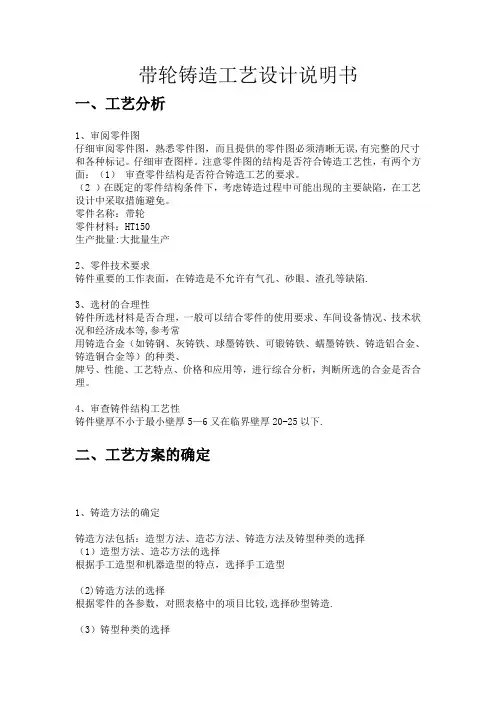
带轮铸造工艺设计说明书一、工艺分析1、审阅零件图仔细审阅零件图,熟悉零件图,而且提供的零件图必须清晰无误,有完整的尺寸和各种标记。
仔细审查图样。
注意零件图的结构是否符合铸造工艺性,有两个方面:(1)审查零件结构是否符合铸造工艺的要求。
(2 )在既定的零件结构条件下,考虑铸造过程中可能出现的主要缺陷,在工艺设计中采取措施避免。
零件名称:带轮零件材料:HT150生产批量:大批量生产2、零件技术要求铸件重要的工作表面,在铸造是不允许有气孔、砂眼、渣孔等缺陷.3、选材的合理性铸件所选材料是否合理,一般可以结合零件的使用要求、车间设备情况、技术状况和经济成本等,参考常用铸造合金(如铸钢、灰铸铁、球墨铸铁、可锻铸铁、蠕墨铸铁、铸造铝合金、铸造铜合金等)的种类、牌号、性能、工艺特点、价格和应用等,进行综合分析,判断所选的合金是否合理。
4、审查铸件结构工艺性铸件壁厚不小于最小壁厚5—6又在临界壁厚20-25以下.二、工艺方案的确定1、铸造方法的确定铸造方法包括:造型方法、造芯方法、铸造方法及铸型种类的选择(1)造型方法、造芯方法的选择根据手工造型和机器造型的特点,选择手工造型(2)铸造方法的选择根据零件的各参数,对照表格中的项目比较,选择砂型铸造.(3)铸型种类的选择根据铸型的特点和应用情况选用自硬砂.2、浇注位置的确定根据浇注位置选择的4条主要规则,选择铸件最大截面,即底面处。
3、分型面的选择本铸件采用两箱造型,根据分型面的选择原则,分型面取最大截面,即底面。
三、工艺参数查询1、加工余量的确定根据造型方法、材料类型进行查询。
查得加工余量等级为11~13,取加工余量等级为12.根据零件基本尺寸、加工余量等级进行查询.查得铸件尺寸公差数值为10.根据零件尺寸公差、公差等级进行查询。
查得机械加工余量为5.5。
2、起模斜度的确定根据所属的表面类型查得测量面高140,起模角度为0度25分(0。
42°)。
3、铸造圆角的确定根据铸造方法和材料,查得最小铸造圆角半径为3。
锻造工艺设计说明书
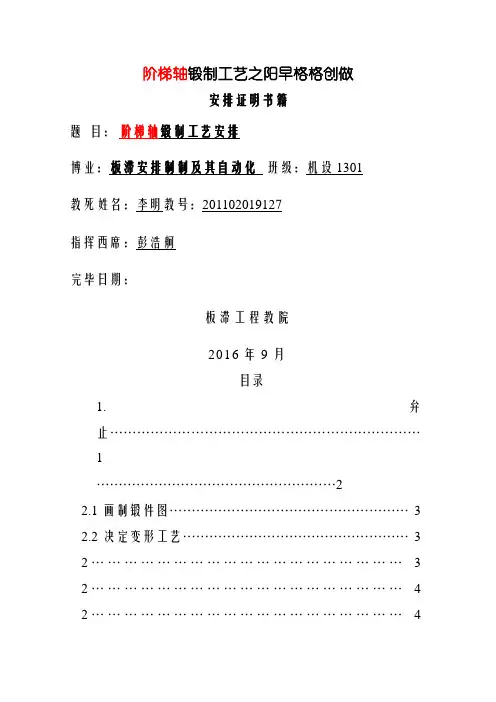
阶梯轴锻制工艺之阳早格格创做安排证明书籍题目:阶梯轴锻制工艺安排博业:板滞安排制制及其自动化班级:机设1301教死姓名:李明教号:201102019127指挥西席:彭浩舸完毕日期:板滞工程教院2016年9月目录1.弁止……………………………………………………………1 (2)2.1画制锻件图 (3)2.2决定变形工艺 (3)2 (3)2 (4)2 (4)2 (4)2.3估计坯料本量战尺寸 (4)2.4选定设备及典型 (5)2.5决定锻制温度及典型 (5)2.6决定热却要收及典型 (5) (6) (8)5.致开……………………………………………………………86.参照文献 (8)锻制的手段是使坯料成形及统制其里里构制本能达到所需的几许形状,尺寸以及本量的锻件.轴是新颖工业洪量使用的整件,本文计划阶梯轴的自由锻死产.2.1画制锻件图锻件图是根据整件图的基础图样,分离锻制工艺特性思量余块、锻件余量战锻制公好等果素画制而成.阶梯轴资料为40Cr,死产批量小,采与自由锻锻制轴坯.轴上的键槽等部分,采与自由锻要收很易成形那些部位,果此思量到技能上的可止性战经济性,决断不锻出,并采与附加余块简化锻件形状,以好处锻制.锻制出轴坯后不妨进一步举止切削加工,末尾成形.根据整件图的尺寸规格,对于照表所列中整件的下度战曲径范畴,不妨查出齿环锻件加工余量战公好.由L=203,Φ=46,对于照《金属成形工艺安排》中表3-3中所列的整件总少为0∽315mm、最大曲径0∽50mm,可查得锻制细度为F级的锻件余量及公好为7±2mm.,而后按查得的公好数值,可画阶梯轴的锻件图.阶梯轴锻件图睹图1.图1 阶梯轴锻件图本理:根据锻件形状、尺寸、技能央供等举止采用,而且先决定锻件成形所需的基础工序、辅帮工序、建整工序,再采用所需的工具并决定工序程序战工序尺寸等.由于阶梯轴是形状较简朴的轴杆类锻件,变形工艺简朴,且资料为时常使用45钢,塑性较佳、简单变形,果此其主要变形工艺普遍为下料、拔少、镦细、拔出锻件等(1)下料(2)完齐拔少(3)压肩并拔少切去余料(4)左边压肩(5)拔少(6)拔少切去料头(7)建整锻件按锻件图举止建整.坯料本量包罗锻件自己的本量、加热时氧化烧益、切头时的益坏及冲孔时的芯料益坏等.即: m坯m=m锻+m烧+m芯+m头M坯=坯料的沉量;m锻=锻件的沉量;m烧=加热时坯料表面氧化而烧益的本量;m芯=冲孔芯料的本量;m切=正在锻制历程中建切端部爆收的料头金属的本量.估计锻件自己的本量: m 锻=ρV式中 m锻=锻件本量;ρ=锻件资料的稀度(kg/dm3 )与7.8kg /dm3 ;V =锻件的体积( dm3 );m锻=π2×22×2×2×1)×若将锻件置于煤气炉中加热,并一次锻成,烧益率按δ=2%估计,即:m烧=m锻×2%果为不冲孔,所以m芯=0截料益坏按锻件本量的4%估计,既得:m头=m锻×锻件以钢材为坯料,锻制比按1.3,可按锻件最大里积Φ=53mm,对于照表所列热轧圆钢尺度曲径,采用Φ,63mm的圆钢.再由m=v ρ算出坯料体积为3,再除以Φ63mm圆钢截里积,便不妨得到坯料少度为105mm2.4选定设备及典型选定锻制设备的依据是锻件资料、尺寸战本量,共时还要适合思量车间现有设备条件.若设备吨位太小,锻件里里锻不透,死产率也矮,反则制成设备战能源的浪费,且支配便当也不平安,常常按体味类比法或者查表法等决定.坯料尺寸为Φ63×故根据《自由锻锤的锻制本收范畴》查得设备应用t的自由锻锤.百般合金钢的锻制温度范畴不妨从表中查出,基础的准则是保证钢正在锻制温度范畴内具备良佳的塑性战较矮的变形抗力,不妨锻制出劣量锻件,且较宽的锻制温度范畴战较少的加热次数,以及较下的死产率.阶梯轴资料40Cr属于合金结构钢,查表可知初锻温度为1200℃,末锻温度为800℃.根据40Cr钢的塑形、强度、导热及伸展系数、构制特性、加热变更、断里尺寸、导热本能战曲径等果素,不妨决定采与火焰炉一段式加热2.6 决定热却要收及典型中小型碳钢战矮合金钢锻后均采与热却速度较快的空热要收.阶梯轴锻件是中小型矮合金结构钢,不妨采与空热的热却办法.三、工艺过程卡阶梯轴锻制工艺卡共步齿环锻制工艺历程卡产品型号整件图号共1 页产品称呼整件称呼阶梯轴第 1 页锻件图资料牌号40Cr资料规格棒料坯料本量/KG坯料可锻件数 1锻件本量/KG加热办法中频加热锻制火次 2班产量/件 3锻件热处理调量处理工序号工序称呼使用设备使用功拆初锻温度末锻温度热却办法锻制工时备注1 下料戴锯无2 加热220KW漏洞式中频加热炉无1150 9503 预锻630吨螺旋压力机阶梯轴预锻模4 末锻630吨螺旋压力机阶梯轴末锻模5 切边100吨切边压力机阶梯轴切边模热切6 考验游标卡尺7 进库标记表记标帜处数变动文献号签名安排:日期:阶梯轴锻制工序卡锻件称呼共步齿环锻件资料40Cr坯料本量坯料尺寸Φ63×105mm锻制设备火次序号支配工序工序简图设备工具备注1 1 下料切割机,电锯或者乙炔气焰切割坯料本量与尺寸可由锻件图算出2 完齐拔少火次序号支配工序工序简图设备工具备注1 3 压肩拔少,切去余料2 4左边压肩并拔少5端部拔少并切料头6 建整按锻件图举止建整体例李明考查接受采与以上工艺不妨锻制出齿环坯,之后只消正在举止切削加工成形便能制制出齿环了.锻制不但是能使其收端成形而且更要害的是锻制不妨革新整件的力教本能,普及它的韧性与强度.5. 致开通过那一次的课程做业,尔深刻的收会到了热加工正在工业死产中的要害职位.尔干的是齿轮的锻制工艺安排,对于齿轮加工的各个历程举止了周到深进的计划,那让尔从中教到了很多,尔以去也会越收齐力去普及与完备自己的知识储备,去里对于以去的处事岗位上逢到的更大的挑拨.正在那次课程安排中彭浩舸教授给了尔很大的帮闲,再次表示感动,更要感动的是尔自己那些天的齐力,付出的汗火会灌溉出乐成的陈花.6. 参照文献【1】王爱珍,热加工工艺前提,北京,北京航空航天大教出版社【2】王爱珍,金属成型工艺安排,北京,北京航空航天大教出版社【3】胡亚民,锻制工艺历程及模具安排,北京,北京大教出版社。
齿轮锻造工艺设计_课程设计说明书
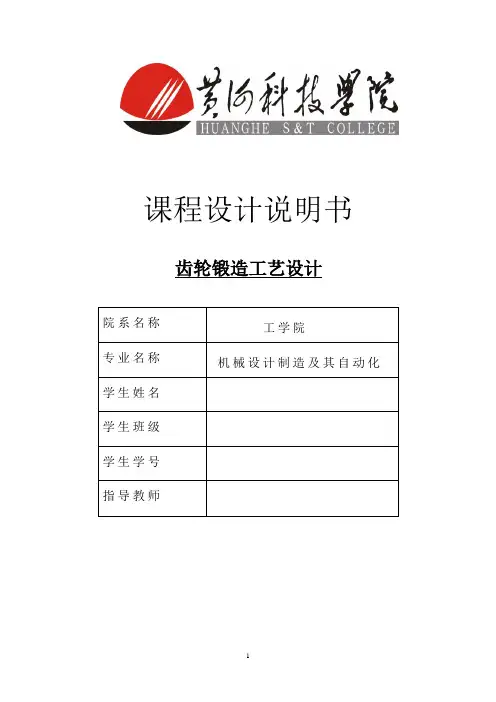
课程设计说明书齿轮锻造工艺设计摘要:本次课程设计说明了齿轮的锻造工艺,同时论述了齿轮零件的锻造工艺设计是一个涉及诸多综合性因素的问题,它与所选的制造机械零件材料的性能、制造的工艺过程、生产的现场条件、生产批量及经济性等因素有密不可分的关系。
只有了解了锻造的工艺要求和热处理的规范,以及选择合适的设备,才能完成齿轮的锻造。
目录一.绘制锻件图................................................. - 1 -1.确定锻件形状.............................................. - 1 -2.确定加工余量.............................................. - 1 -3.确定锻造公差.............................................. - 1 -4.绘制锻件图................................................ - 2 -二.确定锻造工艺............................................... - 3 -1.锻件分类及工序............................................ - 3 -2.制定变形工艺方案.......................................... - 3 -3.确定合适的锻比............................................ - 4 -三.确定毛坯的质量和尺寸....................................... - 5 -1.毛坯质量计算.............................................. - 5 -2.毛坯尺寸确定.............................................. - 6 -四.选定锻造设备及吨位......................................... - 7 -1.查表选定法................................................ - 7 -五.确定锻造温度及规范......................................... - 8 -1.确定锻造温度范围.......................................... - 8 -2.确定加热规范及火次........................................ - 8 -3.确定冷却方法.............................................. - 9 -4.确定冷却规范.............................................. - 9 -5.确定热处理规范............................................ - 9 -六.设计总结.................................................. - 10 - 致谢......................................................... - 11 - 参考文献..................................................... - 12 - 工艺卡....................................................... - 13 -一.绘制锻件图绘制锻件图是拟定锻造工艺规程、选择工具、指导生产和验收锻件的主要依据。
齿轮工艺课程设计说明书
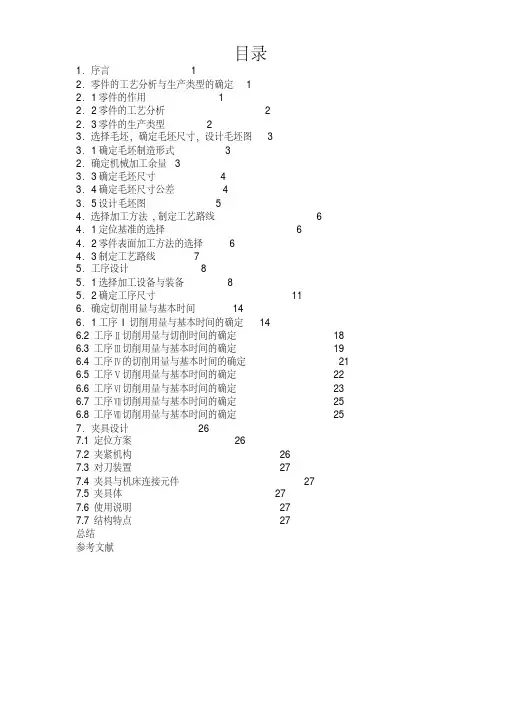
目录1.序言 12.零件的工艺分析与生产类型的确定 12.1零件的作用 12.2零件的工艺分析 22.3零件的生产类型 23.选择毛坯,确定毛坯尺寸,设计毛坯图 33.1确定毛坯制造形式 32.确定机械加工余量 33.3确定毛坯尺寸 43.4确定毛坯尺寸公差 43.5设计毛坯图 54.选择加工方法,制定工艺路线 64.1定位基准的选择 64.2零件表面加工方法的选择 64.3制定工艺路线 75.工序设计 85.1选择加工设备与装备 85.2确定工序尺寸 116.确定切削用量与基本时间 146.1工序I切削用量与基本时间的确定 146.2工序Ⅱ切削用量与切削时间的确定 18 6.3工序Ⅲ切削用量与基本时间的确定 19 6.4工序Ⅳ的切削用量与基本时间的确定 21 6.5工序Ⅴ切削用量与基本时间的确定 22 6.6工序Ⅵ切削用量与基本时间的确定 23 6.7工序Ⅶ切削用量与基本时间的确定 25 6.8工序Ⅷ切削用量与基本时间的确定 25 7.夹具设计 267.1定位方案 267.2夹紧机构 267.3对刀装置 277.4夹具与机床连接元件 277.5夹具体 277.6使用说明 277.7结构特点 27总结参考文献1.序言课程设计在我们学完大学的全部基础课、专业基础课之后进行的,这是我们在进行课程设计对所学各课程的深入综合性的总复习,也是一次理论联系实际的训练,因此,它在我们的大学生活中占有重要的地位。
另外在做完这次课程设计之后,我得到一次在毕业工作前的综合性训练,我在想我在下面几方面得到了锻炼:运用机械制造工艺学课程中的基本理论以与在生产实习中学到的实践知识,正确地解决一个零件在加工中的定位,夹紧以与工艺路线安排,工艺尺寸确定等问题,保证零件的加工质量。
提高结构设计能力。
通过设计夹具的训练,获得根据被加工零件的加工要求,设计出高效,省力,经济合理而能保证加工质量的夹具的能力。
学会使用手册以与图表资料。
齿轮零件加工工艺设计说明书
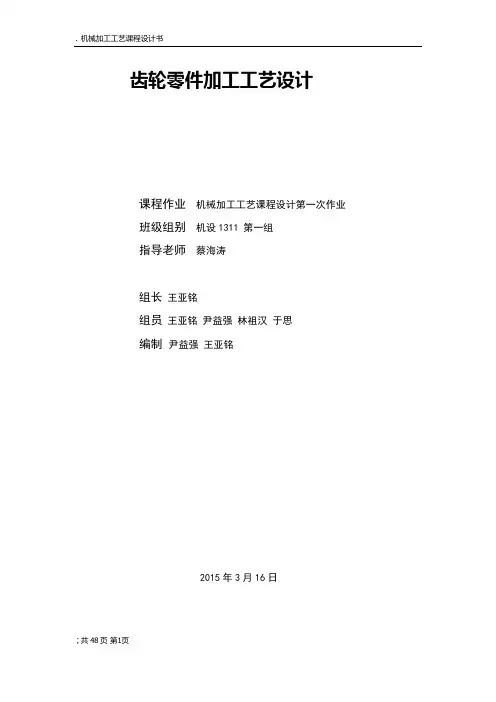
齿轮零件加工工艺设计课程作业机械加工工艺课程设计第一次作业班级组别机设1311 第一组指导老师蔡海涛组长王亚铭组员王亚铭尹益强林祖汉于思编制尹益强王亚铭2015年3月16日目录1 计算生产钢领,确定生产类型 (4)2 审查零件图样的工艺性 (5)3 选择毛胚 (6)4 工艺过程设计 (7)4.1 定位基准的选择 (7)4.2零件表面加工方法的选择 (7)4.3 制定工艺路线 (9)5 确定机械加工余量及毛培尺寸,设计毛培图 (10)5.1 确定机械加工余量 (10)5.2确定毛培尺寸 (10)5.3 设计毛培图 (11)6 工序设计 (15)6.1 选择加工设备与工艺装备 (15)6.2确定工序尺寸 (18)7 确定切削用量及基本事件(机动时间) (24)7.1 工序30切削用量及基本时间的确定 (24)7.2工序40切削用量及基本时间的确定 (29)7.3工序60切削用量及基本时间的确定 (29)7.4 工序70切削用量及基本时间的确定 (32)7.5 工序80切削用量及基本时间的确定 (33)7.6 工序90切削用量及基本时间的确定 (34)7.7 工序100切削用量及基本时间的确定 (36)7.8 工序110切削用量及基本时间的确定 (38)8 三维造型图 (39)附件一丶零件图二丶机械加工工艺过程卡三丶机械加工工序卡四丶零件检验卡1 计算生产纲领,确定生产类型图7.1—1所示为某产品上的一个齿轮零件。
该产品年产量为2000台,设其备品串为10%,机械加工废品串为1%,现制订该齿轮零件的机械加工工艺规程。
N=Q n(1+α%十β%)=8000 X1(1十5%十1%) 件/年=8480件/年齿轮零件的年产旦为2220件,现已知该产品届于轻型机械,根据表1.1-2于生产纲领的关系,可确定其生产类型为中批生产。
2 审查零件图样的工艺性齿轮零件图样的视图正确、完整,尺寸、公差及技术要求齐全。
但基推孔Φ68K7m m要求Ra o.8μm有些偏高。
齿轮锤锻模设计说明书
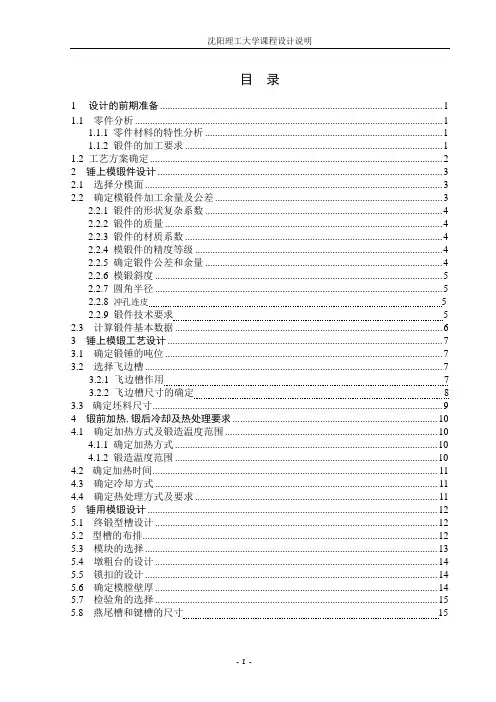
目录1 设计的前期准备 (1)1.1 零件分析 (1)1.1.1 零件材料的特性分析 (1)1.1.2锻件的加工要求 (1)1.2 工艺方案确定 (2)2 锤上模锻件设计 (3)2.1 选择分模面 (3)2.2 确定模锻件加工余量及公差 (3)2.2.1锻件的形状复杂系数 (4)2.2.2锻件的质量 (4)2.2.3锻件的材质系数 (4)2.2.4模锻件的精度等级 (4)2.2.5确定锻件公差和余量 (4)2.2.6模锻斜度 (5)2.2.7 圆角半径 (5)2.2.8 冲孔连皮52.2.9 锻件技术要求 52.3 计算锻件基本数据 (6)3 锤上模锻工艺设计 (7)3.1 确定锻锤的吨位 (7)3.2 选择飞边槽 (7)3.2.1 飞边槽作用73.2.2 飞边槽尺寸的确定83.3确定坯料尺寸 (9)4 锻前加热,锻后冷却及热处理要求 (10)4.1 确定加热方式及锻造温度范围 (10)4.1.1确定加热方式 (10)4.1.2锻造温度范围 (10)4.2确定加热时间 (11)4.3 确定冷却方式 (11)4.4 确定热处理方式及要求 (11)5 锤用模锻设计 (12)5.1 终锻型槽设计 (12)5.2型槽的布排 (12)5.3 模块的选择 (13)5.4 墩粗台的设计 (14)5.5 锁扣的设计 (14)5.6 确定模膛壁厚 (14)5.7 检验角的选择 (15)5.8 燕尾槽和键槽的尺寸155.9 起重孔的设计15 参考文献 (16)1设计的前期准备1.1零件分析1.1.1零件材料的特性分析45号优质碳素钢:抗拉强度≥600(MPa);屈服强度≥355(MPa);延长率≥16%;断面收缩率≥40%;布氏硬度≤197特性及应用;未热处理时:HB≤229;热处理:正火;冲击功:Aku≥39J强度较高,塑性和韧性尚好,用于制作承受负荷较大的小截面调质件和应力较小的大型正火零件;以及对心部强度要求不高的表面淬火零件,如曲轴、传动轴、齿轮、蜗杆、键、销等。
齿轮模具标准设计方案英文版
齿轮模具标准设计方案英文版Gear Mold Standard Design PlanGear molds are a crucial component in the manufacturing of various types of gears. They are responsible for producing precise and consistent gears that meet the high standards of today's industries. To ensure the highest quality of gear molds, it is necessary to have a standardized design plan that outlines all the essential features required for producing these essential components.Below we outline a standard design plan for gear molds, including the key elements that make up a high-quality mold.Design OverviewThe design process for a gear mold involves several critical steps. These include:1. Part design - The first step is to create a CAD model of the part that will be produced by the gear mold. This model should include all the necessary features, such as the gear teeth, shaft, and housing.2. Mold design - Once the part design is complete, the next step is to design the mold that will produce the part. This involvesdetermining the number of cavities needed, the gate location and size, and the position of the ejector pins.3. Mold flow analysis - To ensure the mold design is optimal, mold flow analysis should be conducted to confirm that flow through the mold is uniform and that the cooling system is operating correctly.Key Features of a Gear Mold DesignThe following are the critical features that should be included in any standard gear mold design:1. Cavity and cores - The mold should contain precisely machined cavities and cores that accurately replicate the desired shape of the gear.2. Gate location - The gate should be placed in a location that allows for uniform flow of material and minimizes the appearance of flow marks or weld lines.3. Ejector system - The mold should include an ejector system that is capable of removing the gear from the mold without damaging its surface.4. Cooling system - An efficient cooling system should be included in the mold design to ensure that the cooling time is optimal, preventing warping and minimizing cycle times.5. Venting - Proper venting should also be included in the mold design to prevent air from being trapped, which can lead to defects such as burning.6. Surface finish - A high-quality surface finish should be achieved on the mold surface to reduce the risk of defects such as warpage or flash.7. Tolerances - The mold design should be made with tight tolerances to ensure that the final gear has the required precision and consistency.Material SelectionThe material selection for the mold itself is just as crucial as the mold design. The material should have good thermal conductivity, be resistant to wear and tear, and be easy to machine accurately. The following are the most commonly used materials for gear mold construction:1. Tool steel - Tool steel is the most common material used for gear molds due to its high strength and excellent wear resistance.2. Stainless steel - Stainless steel is used in applications where corrosion resistance is essential.3. Aluminum - Aluminum is an option for low-volume production as it can be machined easily, but it may not be as durable as other materials.ConclusionThe design of high-quality gear molds is essential to the production of precise and consistent gears that meet the high standards of today's industries. By following a standardized design plan that incorporates the essential features discussed above, gear mold manufacturers can ensure that they produce molds that are efficient, effective, and built to last.。
齿轮传动的参数化设计及制造工艺设计说明书
齿轮传动的参数化设计及制造工艺ee(ee)指导老师:ee[摘要]本课题在研究快速设计的理论、方法和技术的基础上,通过对常用圆柱齿轮减速器结构的深入分析,采用实体建模、模块化、参数化等技术开发渐开线圆柱齿轮减速器。
介绍如何在Pro/E下实现渐开线标准齿轮的参数化设计,找出主要齿轮参数,对模型尺寸通过关系式进行控制,当用户对主要参数进行修改后,通过在生成处理即获得新的模型。
[关键字]Pro/E、参数化设计、渐开线齿轮Gear parametric design and its manufacturingprocessee(ee)tutor:ee[Abstract]Based on the subjects in the study of the rapid design theory, method and technology .Commonly used by the cylindrical gear reducer structure ing solid modeling, modular, parametric technology development of involute cylindrical gear reducer.How to introduce Pro/E to realize the parametric design of standard involute gear.Find out the main gear parameters.On the size of the model through the relationship type control.When the user on the main parameters of the modified through the generating process is to obtain a new model.Parametric design is convenient, applicable to the structural shape of amorphous products.[Key words] Pro/E ;parameter design ;standard involute gear目录绪论 (1)1.传动机构的总体设计 (4)1.1传动方案拟定 (4)1.2 电机的选择 (5)1.2.1电动机类型和结构型式的选择: (5)1.2.2 确定电动机的功率: (5)1.3计算总传动比及分配各级传动比 (5)1.4运动参数及动力参数计算: (5)1.4.1计算各轴转速: (5)1.4.2计算各轴的功率: (6)1.4.3计算各轴转矩: (6)2.传动零件的设计计算:............................................................................................ 错误!未定义书签。
齿轮锻造工艺设计说明书
齿轮锻造工艺设计说明书姓名:xxx学号:xxxxxxxx班级:xxxxxxx日期;xxxxxxx齿轮锻造工艺设计说明书摘要:锻造生产的目的是坯料成型、及控制其内部组织性能达到所需的几何形状,尺寸以及品质的锻件,钢和大多数非铁金属及合金具有不同程度的塑性,均可在冷态或热态下进行塑性加工成型。
齿轮的锻造采用的是自由锻工艺。
本文主要介绍的是齿轮的自由锻工艺。
自由锻是利用压力或冲击力是金属在上下抵铁之间产生塑性变形,从而获得所需锻件形状及尺寸的方法。
确定自由锻的工艺成为了自由锻加工的关键。
本文着重介绍的就是齿轮的自由锻的工艺流程。
关键词:自由锻、齿轮加工、塑性变形、工艺流程。
目录一.绪论 (1)二.总体设计方案 (1)三.具体的设计方法与步骤 (3)3.1绘制锻件图 (3)3.2确定变形工艺 (3)3.2.1镦粗 (3)3.2.2冲孔 (4)3.2.3扩孔 (4)3.2.4修整锻件 (4)3.3计算坯料质量和尺寸 (4)3.4选定设备及规范 (5)四.工艺流程(工艺卡) (6)五.结论 (7)六.致谢 (7)七.参考文献 (8)一、绪论锻造的目的是使坯料成形及控制其内部组织性能达到所需的几何形状,尺寸以及品质的锻件。
锻造的基本工艺有自由锻、模锻、板料冲压等,其中自由锻和模锻是热塑性成型,而板料冲压是冷塑性成形,两者的基本原理相同。
锻造件占得比例说明了一个国家生产水平、生产率、材料利用率、生产成本及产品品质在国际竞争中的地位。
在新中国成立之前,锻造基本上是手工作坊式的延续,生产效率低,劳动强度大。
然而在改革开放之后我国的锻造工艺水平得到了迅猛的发展,从而带动了诸如汽车工业的跨越式发展。
但我们还应该清醒的看到我们的锻造工艺水平与欧美发达国家还有一定差距,这更加促使我们努力发展新技术,赶超国际先进水平。
齿轮是现代工业大量使用的零件,本文就是讨论齿轮的自由锻生产。
自由锻能进行的工序很多,可分为基本工序、辅助工序、及精整工序三大类。
齿轮轴零件加工工艺设计说明书
机械工程学院机制专业课程设计说明书设计题目:齿轮轴零件加工工艺设计说明书专业:机械设计制造及其自动化班级: 09级机制四班姓名: 1111 学号 06123323299990 指导教师:王立华2012年12 月30日目录绪论 (1)1.零件的分析 (1)1.1 零件的作用 (1)1.2 零件材料的分析 (2)1.3 确定生产类型 (2)1.4 毛培的确定 (3)1.5 确定毛培的种类 (4)1.6 绘制铸件零件图 (4)2. 加工工艺过程分析 (6)2.1 加工工艺过程的组成 (6)2.2 定位基准的选择原则 (6)2.3 零件表面加工方法的选择 (8)2.4 加工程序安排 (9)2.5 热处理工序的安排 (9)2.6 工序划分 (9)2.7 加工余量及工序尺寸的确定 (10)3 .选择加工设备及工艺设备 (13)3.1 机床的作用 (13)3.2 刀具的选择 (14)3.3 夹具的确定 (17)3.4 量具的选择 (19)4 .工艺卡的选择 (23)4.1 工艺卡的拟定 (23)4.2 问题的提出 (26)5 .设计总结 (29)6 .参考文献 (30)绪论本课题的研究主要是加工工艺的注意点和改进的方法,通过总结零件的的加工,提高所加工工件的质量,完善产品,满足要求,提高经济效益和劳动生产率。
一般齿轮轴有两个支撑轴径,工作时通过轴径支撑在轴承上,这两个支撑轴径便是其装配基准,通常也是其他表面的设计基准,所以它的精度和表面质量要求较高。
对于一些重要的轴,支撑轴除规定较高的尺寸精度外,通常还规定圆度、圆柱度以及两轴径之间的同轴度等形状精度要求等。
对于其他工作轴径,如安装齿轮、带轮、螺母、轴套等零件的轴径,除了有本身的尺寸精度和表面粗糙度外,通常还要求其轴线与两支承轴径的公共线同轴,以保证轴上各运动部件的运动精度。
轴为支承转动零件并与之一起回转以传递运动、扭矩或弯矩的机械零件。
一般为金属圆杆状,各段可以有不同的直径。
- 1、下载文档前请自行甄别文档内容的完整性,平台不提供额外的编辑、内容补充、找答案等附加服务。
- 2、"仅部分预览"的文档,不可在线预览部分如存在完整性等问题,可反馈申请退款(可完整预览的文档不适用该条件!)。
- 3、如文档侵犯您的权益,请联系客服反馈,我们会尽快为您处理(人工客服工作时间:9:00-18:30)。
齿轮锻造工艺设计说明书(Gear forging process design manual)Gear forging process design manualAbstract: the purpose of forging blank molding, and control of its internal organizational performance reached the desired geometry, size and quality of forgings, steel and non-ferrous metal and alloy has the most plastic in different degrees, can be plastic molding process in cold or hot. The forging of gears adopts the free forging process. This paper mainly introduces the free forging process of gears. Free forging is the use of pressure or impact force is the metal between the upper and lower iron deformation between plastic deformation, so as to obtain the shape and size of the required method. The determination of free forging becomes the key to free forging. This article focuses on the process of free forging of gears.Keywords: free forging, gear processing, plastic deformation, process flow.CatalogI. introduction............................................... ............. OneTwo. Overall design plan................................................ OneThree. Specific design methods and steps.................................... Three3.1 draw the forging drawing............................................. Three3.2 determine the deformation process.......................................... Three3.2.1 upsetting............................................. Three3.2.2 punching............................................. Four3.2.3 reaming............................................. Four3.2.4 trimming forgings....................................... FourThree3 calculate billet quality and size................................. Four3.4 selection of equipment and specifications (iv)Four. Process flow (process card)....................................... SixFive. Conclusion............................................................ SevenSix. Thanks..................................................... ....... SevenSeven. References................................................. ..... EightManufacturability analysis of forging structureforging drawingParameter selectionDetermination of machining allowance and determination of tolerancesDetermine billet qualityDetermination procedureSelection of forging equipmentDetermination of heating temperature and heating timePost forging heat treatmentThe 1. part drawing process, attached to the instructions, the A4 paper to print or freehand.2. front cover format:1. design specifications must be written, with A4 paper, cover, catalogue, text and references.Advanced design and manufacturing integrated experimentXX part XX process designclassFull nameI. IntroductionThe purpose of forging is to make the blank forming and to control its internal structure to achieve the required geometry, size and quality of the forgings. The basic process of forging is free forging, die forging, sheet metal stamping, in which free forging and die forging are thermoplastic forming, and sheet stamping is cold plastic forming, the basic principle of both is the same.The proportion of forged parts shows the status of a country's production level, productivity, material utilization, production costs and product quality in international competition. Before the founding of new China, forging was basically a continuation of handicraft workshops, with low production efficiency and great labor intensity. However, after the reform and opening up, China's forging technology hasbeen rapid development, which led to the automotive industry, such as leaps and bounds. But we should also clearly see that our forging technology level and European and American developed countries still have a certain gap, which makes us more efforts to develop new technologies, catch up with the international advanced level.Gear is a large number of parts used in modern industry. This paper discusses the free forging production of gears. Free forging can be carried out a lot of processes, can be divided into basic processes, auxiliary processes, and finishing process three major categories. Its basic process is to make the metal produce a certain degree of plastic deformation in order to achieve the desired shape and size of the process, such as upsetting, drawing, punching, bending, cutting, twisting and dislocation and other processes.Two, the overall design1. draw the forging drawingAccording to the basic drawing of parts drawing, combined with the characteristics of free forging, the residual parts, forgings allowance and forging tolerances are drawn.2. calculate billet quality and size(1) calculation of billet quality;According to the shape and size of forging, forging quality can be calculated first, then consider the oxidation loss duringheating, loss of core material and flush cutting head punching, quality first for the calculation of blank forgings, the calculation formula is as followsM billet, =m forging, +m firing, +m head, +m core(2) determination of blank size;The leather size are correlated with the first basic process, because the gear is cake or hollow forgings, with upsetting forging process, in order to avoid upsetting bending, should make the blank height h of not more than 2.5 times the diameter of D, which bases on the ratio of height to diameter less than 2.5 h/D. In order to facilitate operation during cutting, the blank height h should be less than 2.5D, that is, the ratio of height to diameter should be greater than 1.25Diameter of round material.3. choose the forging processGear forging, according to its lateral size greater than or near the height of the characteristics, mainly to upsetting the main, when the forging has a convex shoulder, according to the size of the shoulder pad selection ring, upsetting or partial upsetting. If the forging hole needs to be rushed out, it needs to be punched.4. selected forging equipmentThe selection of forging equipment is based on the material,size and quality of the forgings, as well as the existing equipment conditions of the workshop. If the equipment tonnage is too small, the forging internal is not thorough, the productivity is low, but the equipment and power waste, and the operation is inconvenient and unsafe, usually by empirical analogy or look-up table method.(1) empirical analogyAccording to the empirical formula of hammer tonnage:The upsetting forging hammer tonnage G= (0.002-0.0003) KS (kg)(2) look-up table selectionFor low carbon steel, medium carbon steel and ordinary low alloy steel, the free forging can be checked by the selected tonnage.5. determine the forging temperature and specifications(1) determine the range of forging temperatureThe forging temperature range of all kinds of alloy steel can be found from the table. The basic principle is to ensure that the steel has good plasticity and low deformation resistance in the range of forging temperature, and can forge high quality forgings,And a wide range of forging temperature and less heating times, as well as higher productivity.(2) determine the range of heating and coolingFor the carbon structural steel with a good thermal conductivity and a diameter of less than 150~200mm, a section of heating code shall be adopted, and the furnace shall be controlled at a temperature of 1300 ~1350 c.. When the billet is heated to the initial forging temperature, it is immediately baked and forged.(3) determination of cooling methods and specifications;Choose air cooling, pit cooling or furnace cooling as required. Small and medium carbon steel and low alloy steel are forged by air cooling method with faster cooling rate. Carbon tool steel, alloy tool steel and bearing steel, forged, air cooled, blown, or sprayed quickly to 200 degrees, then put the forgings into a pit or cooled in a furnace.Three, the specific design methods and steps1. draw parts drawingThe material of this part is 40Cr, and the production is small in quantity. The gear blanks are forged by free forging.The gear on the circumference of the small groove shoulder and 8 x 30mm diameter hole part, the free forging method is very difficult to form these parts, considering the feasibility and economy of technology, and decided not forged, and the additional block shape to simplify the forging, forging. After forging the gear blank, it can be further processed and finallyAccording to the dimension of the parts drawing, the height and the diameter of the parts listed in the comparison table, the allowance and tolerances for the machining of the gear forgings can be found out. D=289, h=52, machining allowance and tolerance check for horizontal forging forging height direction a=10 + 4, b=9 + 3, c=13 + 5 hole bilateral, and press check tolerances can be drawn numerical Shoulder Gear Forging drawing.Forging drawing is given separately.2. determine the deformation processConvex shoulder shaped gear forgings belongs to the hollow part, according to the shape and size of forgings, forging in the forging hammer, and the main deformation process for upsetting and punching, punch reaming process, the auxiliary cushion ring upsetting forming is determined according to the forging of the shoulder shape.At present, these kinds of short swords generally use partial upsetting, while upsetting forming is suitable for shoulder forgings with small diameter and height. Because the gear diameter is larger, so we decide to use the punch reaming, but considering the punching metal will flow along the radial hole, and along the height direction of the shoulder pulling shrinkage phenomenon, so that the cushion ring upsetting after the diameter size should be smaller than the diameter of the forging, and shoulder height should be greater than the forging(1) upsettingSince the forgings are single sided, the pad ring shall be upset, and the ring size shall be determined here.Cushion ring cavity volume V pad should be more than the volume of the forging shoulder volume V, shoulder big 10% - 15% (thick wall take small value, thin wall take big value), this case take 12%, calculate V shoulder =753253mm3. beV pad = (1+12%) V shoulder =1.12 * 753253=843643 mm3Taking into account the hole will produce shrinkage, cushion ring height H pad should be increased by 15% to 30% than the convex shoulder (thick wall take small value, thin-walled take big value), this example take 20%.H pad, =1.2H shoulder, =1.2 * 34=40.8 (mm), take 40mm. The inner diameter of the cushion ring D pad can be inconvenient to obtain according to the volumeThe inner wall of the cushion ring should have a slope of 7 degrees, and the upper aperture shall be 163mm, and the lower end aperture shall be 154mm.In order to remove the oxide, the flat anvil upsetting shall be carried out before the pad ring upset, and the process is shown as shown in fig.. After upsetting the flat anvil, the diameter of the billet should be slightly smaller than the innerdiameter of the gasket ring, and the diameter of the upper flange at the upper flange shall be smaller than the maximum diameter of the forging ring after upsetting.(2) punchingPunching punching should make the core material loss is small, while expanding the number of not too much, D punching hole diameter should be less than or equal to D/3 or D at less than D/3=213/3=71mm, the practical use of d=60mm.(3) reaming;The total reaming amount is the hole diameter of the forging minus the punching diameter, that is, (131-60) =71mm, the amount of reaming is 25~30mm in general, and the amount of reaming is 21mm, 25mm and 25mm respectively.(4) trimming forgingsTrim according to the forging drawing.3. calculate billet quality and sizeThe quality of the billet is equal to the quality of the forging, plus the quality of the core and the quality of burning. The quality of the forgings is calculated according to the formulaM forging =V forged P = Pi /4 (32 * 0.27+2.112 * 0.34+1.322 * 7.8=17.8kg * 0.61)Quality of punched core material (take d=60mm, H=65mm) asM core = (1.18~1.57) D2 * H=0.3kgThe gas furnace heating billet loss rate u =2%, considering the need of forging after 2~3 reaming, and requires at least 2 heating, therefore should take the upper limit of single fire damage rate plus appropriate loss value is =0.035, so the quality of the billet is burningM burn =17.8 * 0.035kg=0.6kgTherefore, the quality of the blank isM billet, =m forging, +m firing, +m head, +m core, =18.7kgWhen calculating the diameter of the blank, the die can be calculated by upsetting:Table look-up shows that the diameter of standard hot rolled round bar is determined by the diameter of the selected billet D=120mm.Billet lengthThus, the blank size is determined to be Phi 120 * 210mm.4. selection of equipment and specificationsThe forging type belongs to the ring, D=289, H=52, the look-up table should be used 5kN hammer. 40Cr is an alloy structuralsteel. The temperature of the starting forging is 1200 degrees and the final forging temperature is 800 degrees. Because of the forging is the diameter of 200~350mm medium carbon structural steel, the three stage gas furnace heating specification, charging temperature of 1150 DEG ~1200 DEG, the holding time is about the total heating time (1h~100min) 5%~10%, here is 15min with maximum insulation, heating speed is heated to 1200 DEG C after thermal insulation again about 15min after the start of forging.Cooling method: the forging is a kind of medium and low alloy structural steel, and it can be cooled by air cooling.Four 、 process flow (process card)Forging name, gear (forging drawing shall be given separately)Forging material 40CrBillet quality 18.7kgBlank Size 120 * 210mm0.5T free forging hammer forging equipmentSchematic diagram of fire operation procedure1 blankingThe quality and size of the billet can be calculated from the forging drawing at phi 120 * 210mmUpsettingLocal upsetting of cushion ringH pad =40mm,D pad =164mm2 punchingD Chong =60mmPunch reamingIt is divided into three reaming, and each reaming amount is 21mm, 25mm, 25mmDressingTrim according to the forging drawingFive. ConclusionBy using the above process, the gear blanks can be forged, and then the gears can be produced as long as the cutting process is formed. I think why not directly machining, but advanced forging it? The reason must be that forging can not only make its initial shape, but more importantly, forging can improve the mechanical properties of parts and improve its toughness and strength. Therefore, the key parts of the key parts shouldbe forged first, then cut into shape.Six, thanksThrough this hot processing course design, I deeply understand the importance of hot processing in industrial production. I do is the forging process design of gear, the process of gear machining are deeply discussed, which let me learn a lot, and I will be more efforts to improve and perfect their knowledge, to face greater challenges in future work. In this course design, XXX teacher gave me great help, thank you once again, but also to thank my own efforts of these days, the sweat will be watered out of successful flowers.Seven. References[1] Wang Aizhen, foundation of hot working technology, Beijing, Beihang University press[2] Wang Aizhen, metal forming process design, Beijing, Beihang University press[3] Hu Yamin, forging process and die design, Beijing, Peking University press。
